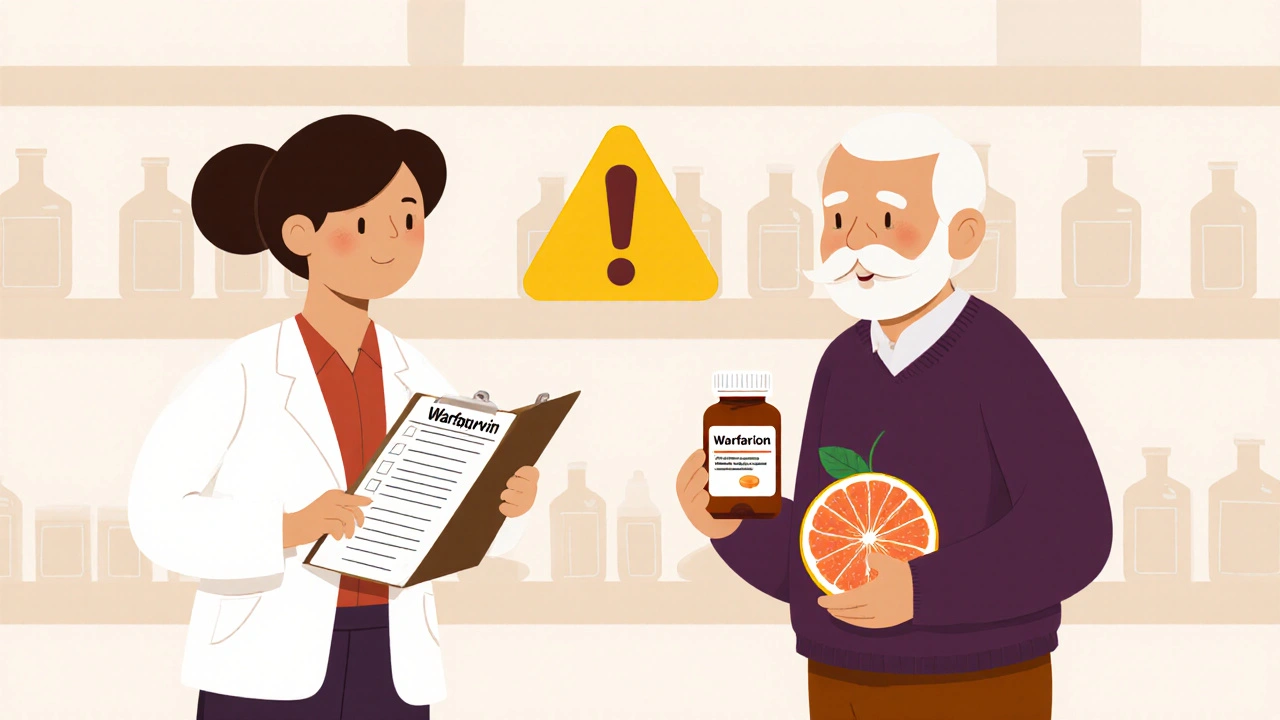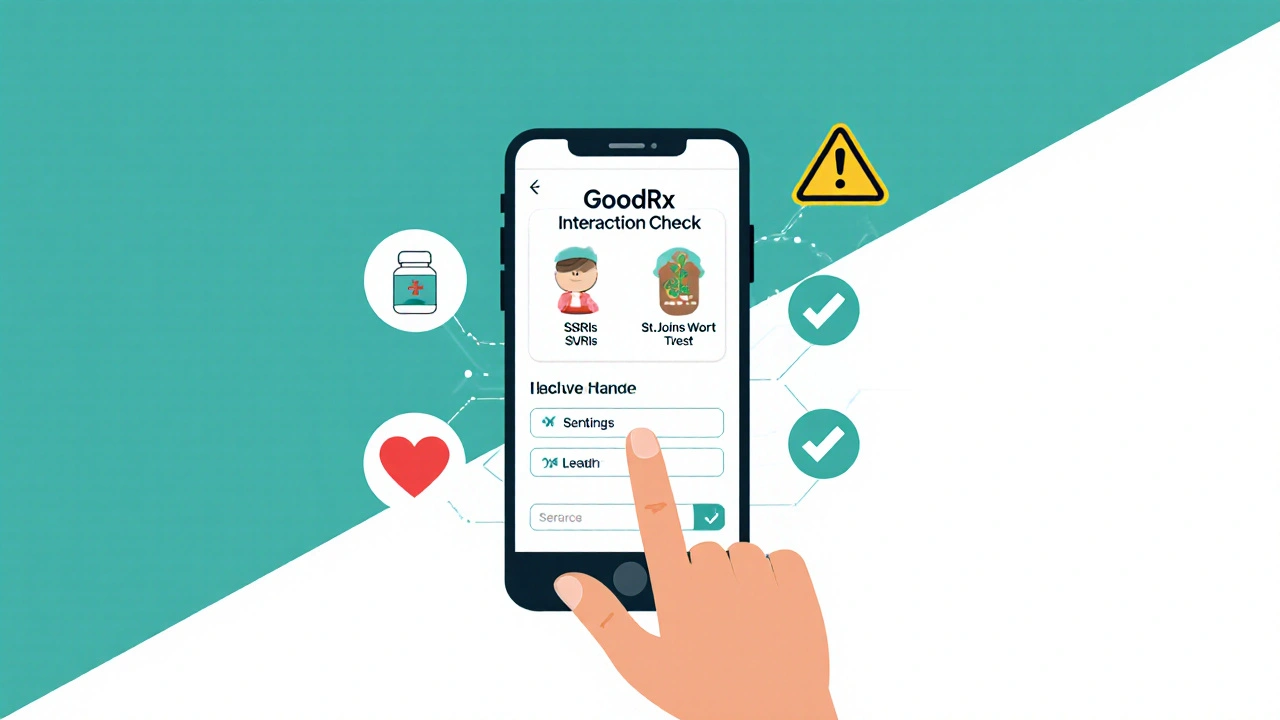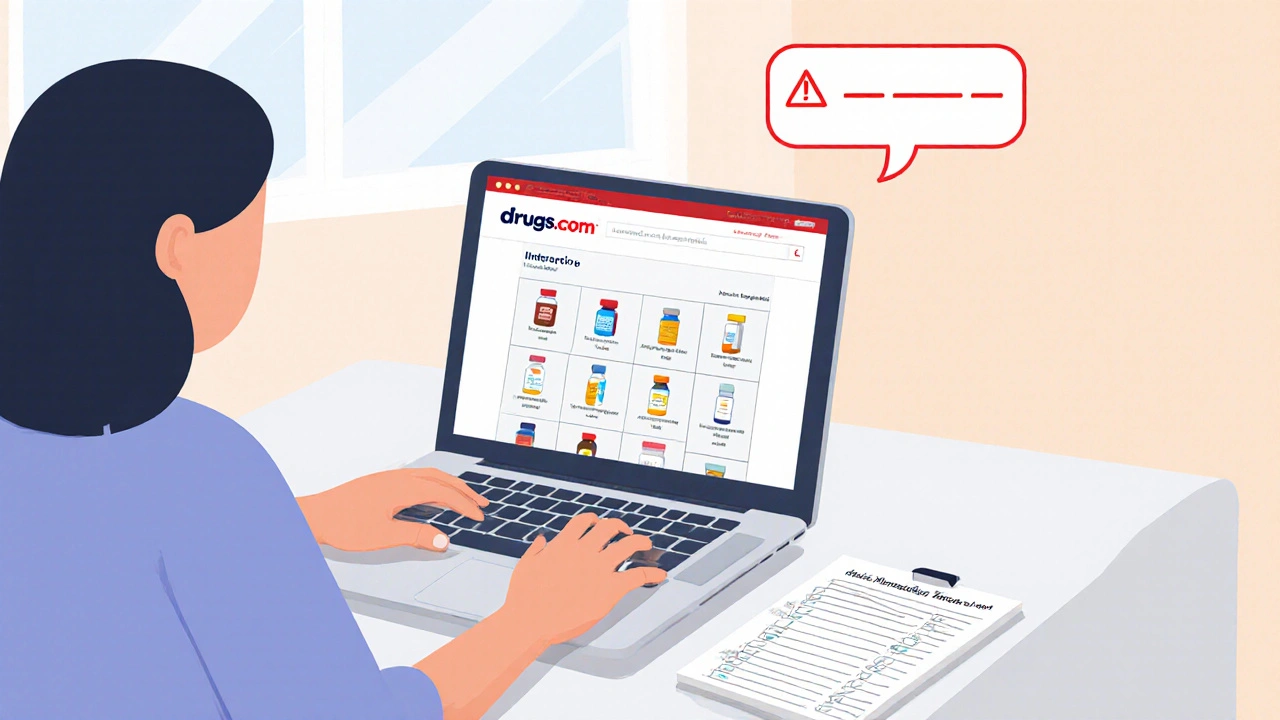Every year, over 1.3 million people in the U.S. end up in the emergency room because of dangerous drug interactions. Many of these cases could have been avoided with a simple check at home - if you know how to do it right. You’re not alone if you’re taking a mix of prescription pills, over-the-counter meds, vitamins, or herbal supplements. Nearly 40% of adults over 65 take five or more medications daily. Even younger adults are stacking pills for sleep, pain, anxiety, or energy. But mixing them without knowing the risks? That’s where things go wrong.
Understand What a Drug Interaction Really Means
A drug interaction happens when two or more substances affect each other’s behavior in your body. This can make a drug stronger, weaker, or cause unexpected side effects. There are three main types:- Drug-drug interactions - like taking warfarin with ibuprofen, which can increase bleeding risk.
- Drug-food/drink interactions - like grapefruit juice making cholesterol meds too strong, or alcohol making sedatives dangerously sleepy.
- Drug-condition interactions - like taking decongestants if you have high blood pressure, which can spike it further.
Use a Trusted Online Drug Interaction Checker
You don’t need a pharmacy degree to check for interactions. Free, reliable tools exist - and they’re updated daily. The best ones are:- Drugs.com Interaction Checker - covers over 24,000 prescription drugs, 4,000 OTC meds, and 3,000 supplements. It’s the most comprehensive and updated every day.
- WebMD Drug Interaction Checker - easier to read, with color-coded severity levels (red = major, yellow = moderate, green = minor). But it misses some supplements and newer drugs.
- GoodRx Interaction Checker - not only flags risks but suggests cheaper, safer alternatives if a dangerous combo is found.
Prepare Your Complete Medication List First
Before you type anything into a checker, make a real, accurate list. Don’t rely on memory. Go through your medicine cabinet. Write down:- Brand name and generic name for every pill
- Dose (e.g., 10 mg, 500 mg)
- How often you take it (once daily, twice a day, as needed)
- Why you take it (e.g., “for blood pressure,” “for occasional headaches”)
- OTC painkillers (ibuprofen, acetaminophen)
- Vitamins (especially vitamin K, which affects blood thinners)
- Herbs (St. John’s Wort, garlic, ginkgo - they’re not harmless)
- Supplements (magnesium, fish oil, melatonin)
- Even topical creams or patches (like lidocaine or nicotine patches)

Interpret the Results - Don’t Panic
Once you get results, don’t stop your meds. Don’t assume every alert is life-threatening. Here’s how to read them:- Major (red) - Contact your doctor or pharmacist immediately. Don’t wait. Examples: mixing SSRIs with MAO inhibitors, or statins with grapefruit juice.
- Moderate (yellow) - Note it. Schedule a call with your pharmacist. You might need a dose change or timing adjustment. Example: taking metformin with certain antacids reduces absorption.
- Minor (green) - Monitor for side effects. You might feel a bit more tired or have mild stomach upset. Still worth mentioning at your next checkup.
Know When to Call Your Pharmacist - Not Just Your Doctor
Your pharmacist is your best ally for drug interactions. They see your full prescription history. They know which generics are interchangeable. They’re trained to spot hidden risks. If you find an interaction:- Call your pharmacy. Ask: “I used Drugs.com and found this combo - is it safe?”
- Ask for a free medication review - most pharmacies offer it.
- Ask if there’s a safer alternative. For example, if you’re on warfarin and need pain relief, acetaminophen is safer than ibuprofen.

Avoid the Biggest Mistakes
Even with tools, people mess up. Here’s what not to do:- Don’t trust random apps. The FDA warned about 17 fake interaction checkers in 2022. Stick to Drugs.com, WebMD, GoodRx, or Medisafe.
- Don’t skip updates. Add new meds to your list the same day you start them. Update your checker every 30 days.
- Don’t assume natural = safe. St. John’s Wort, ginkgo, and garlic can be just as risky as prescription drugs. Many users don’t realize this.
- Don’t stop meds based on a checker alone. A 2022 FDA report found 15% of patients quit essential meds after a minor alert - leading to worse health outcomes.
What’s Next? The Future of Drug Safety
The tools are getting smarter. Drugs.com rolled out an AI-powered severity predictor in September 2023 that better estimates how likely an interaction is to cause harm. GoodRx is teaming up with 23andMe to add genetic data - meaning your DNA could soon help predict which drugs your body handles poorly. By 2024, MyMedicare accounts will integrate interaction checkers directly, so seniors can check their meds in one place. But no app will ever replace human judgment. The CDC projects that if everyone used these tools correctly - and followed up with a pharmacist - we could prevent 150,000 hospitalizations every year. That’s not just data. That’s real people avoiding ER visits, surgeries, and long recoveries.Checking for drug interactions at home isn’t about replacing your doctor. It’s about giving yourself a safety net. It’s about asking the right questions before something goes wrong. Start today. Make your list. Run your meds through Drugs.com. Call your pharmacist. Your body will thank you.
Can I trust free drug interaction checkers?
Yes - if you use trusted ones like Drugs.com, WebMD, or GoodRx. These are backed by clinical databases updated daily and used by hospitals. Avoid random apps from unknown developers. The FDA has flagged 17 fraudulent interaction checkers since 2022. Stick to well-known health sites.
Do I need to check interactions even if I only take one prescription?
Absolutely. Most people take more than one thing. Even if you’re on one prescription, you might also take ibuprofen for pain, a vitamin D pill, or melatonin for sleep. These can interact. For example, vitamin K can reduce the effect of blood thinners like warfarin. Always check your full list - not just your prescription.
What if the checker says there’s an interaction but my doctor says it’s fine?
That happens. Doctors sometimes prescribe combos that are risky but necessary - like a strong painkiller with a sleep aid for cancer patients. Ask your doctor: “Why is this safe for me?” They should explain the benefit vs. risk. If they can’t give a clear reason, get a second opinion from your pharmacist. Never assume your doctor knows every interaction - they’re human, and they’re busy.
Are herbal supplements really dangerous with medications?
Yes. Many people think “natural” means safe, but that’s not true. St. John’s Wort can make birth control, antidepressants, and HIV meds useless. Garlic and ginkgo can increase bleeding risk with blood thinners. Fish oil can lower blood pressure too much when combined with meds. Always list supplements on your medication list - they’re not optional.
How often should I check for interactions?
Check every 30 days, or anytime you start, stop, or change a dose of any medication - even if it’s OTC. Your body changes. Your meds change. New interactions appear as new drugs hit the market. The CDC recommends updating your list regularly. Many users only check once a year - that’s too late.
Can I use these tools for my elderly parents?
Yes - and you should. Seniors are at highest risk because they often take five or more medications. Use the tool together. Read the results out loud. Ask their pharmacist to explain any flagged interactions. Apps like Medisafe let you manage multiple profiles, so you can monitor their meds from your phone. This simple step can prevent hospital stays.


Written by Felix Greendale
View all posts by: Felix Greendale